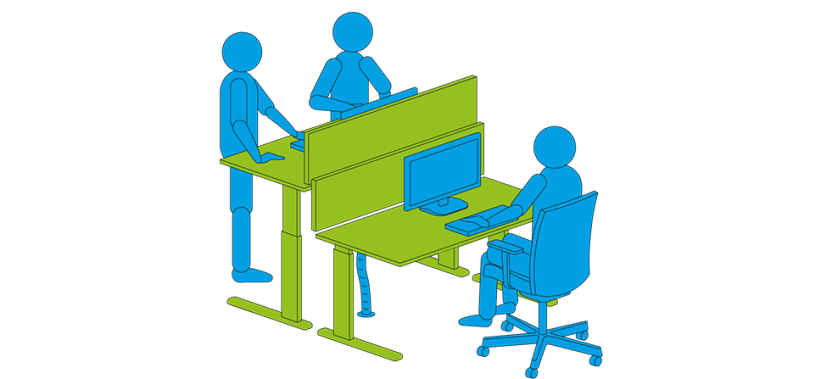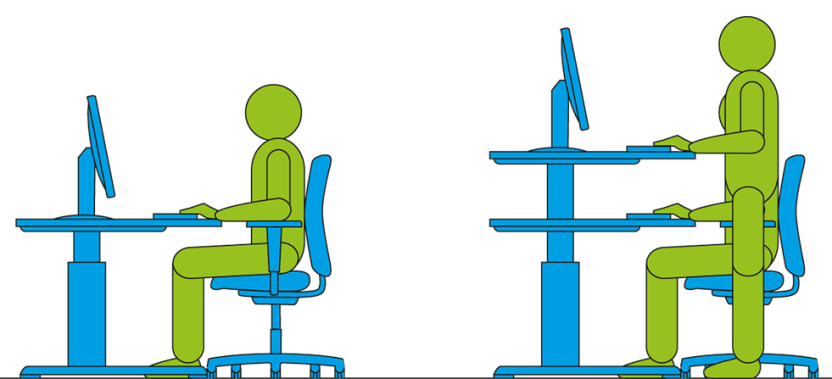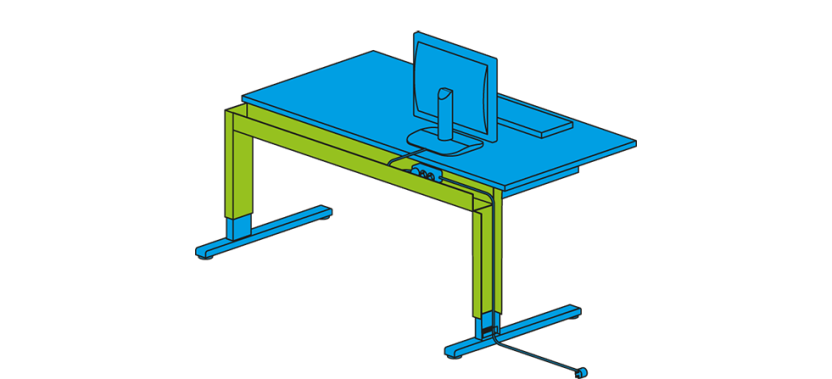


General Requirements
- The desk carries the GS mark for tested safety.
The GS mark guarantees, among other things, the stability, strength and vibration resistance of the frame. GS-certified products are free from hazardous edges and corners and comply with current standards. - The work surface must be sufficiently large.
It must measure at least 160 × 80 cm or 1.28 m². The area of desk-high pedestals or add-on units may be included in the total. However, the desk must always provide a continuous width of at least 120 cm. - The work surface must be at least 80 cm deep.
The viewing distance between eye and screen must be at least 50 cm. For monitors larger than 17” a greater distance is usually required. Screens must not protrude beyond the desk edge. Both requirements may mean that greater desk depth is necessary. - The desk height should be adjustable to suit the user.
The optimal working height is derived from the sitting height. Both upper and lower legs as well as upper and lower arms should form an angle of about 90°. If a desk is permanently used by just one person, it may suffice to set it to the correct height during installation. More flexible are desks that can be adjusted directly by the user. - Ideally, desks should be adjustable not only to individual sitting height, but also to standing height.
The adjustment range should span 65 to 125 cm. Where no sit-stand desks are available, occasional standing work should be made possible with additional furniture or components. - The workstation must provide sufficient legroom and foot space.
During normal use, legs and feet must not come into contact with any obstacles. Compliance can be identified through the GS mark or the Quality Office certification. For the GS mark, check that the product is classified as Type A or Type B according to DIN EN 527–1. Products with the Quality Office label require no further verification; they automatically meet legroom requirements. - Work surfaces must be low-reflection and glare-free.
Strong contrasts between desk surface and work materials can cause eye strain. Shiny surfaces create glare and reflections on screens, which in turn can lead to higher error rates and muscular tension in the neck and shoulders. - The desk must have vertical and horizontal cable management with integrated strain relief.
This is essential at all desks where monitors or other devices are connected to power or data cables. Proper cabling helps to prevent accidents. - All cable routes must be free from sharp edges,
so as to avoid any damage to the cables. - If several furniture elements are cabled together, they must be securely connected.
This applies, for example, to workstation configurations made up of several single desks.
Additional Recommendations for Choosing Sit-Stand Desks
- Height adjustment range
European standards for office desks require a height range of 68 to 118 cm. A wider range of 65 to 125 cm is preferable. - Stability and vibration resistance
If full coffee cups or glasses of water threaten to spill after a light bump against the desk edge, the desk is unsuitable for daily use. Desks must remain largely stable after impact and return quickly to a steady position. - Adjustment mechanism
Height adjustment must be easy to operate. A memory function is ideal, enabling the desk to automatically return to pre-set working heights for sitting and standing. Adjustment must also remain smooth when the work surface is unevenly loaded. - Noise level
While completely silent operation is impossible, height adjustment should be quiet enough not to disturb colleagues. - Collision protection
Sit-stand desks are not hazardous products, but to ensure safety they should nevertheless be fitted with collision protection. This detects when the desktop meets an obstacle and stops the movement immediately. - Cable management
Safe cable routing is particularly important at sit-stand workstations. Monitor and IT device cables must not dangle loosely when the work surface is lowered. - Sustainability
The most convenient and widely used adjustment system is an electric motor. When buying, look for an energy-saving standby mode. Good models use around 0.1 watts. - User information
Every desk should come with user information explaining not only the adjustment features but also how to determine the correct working heights.




